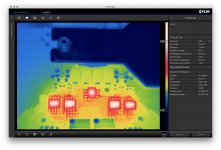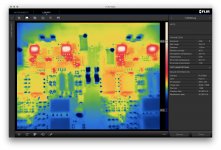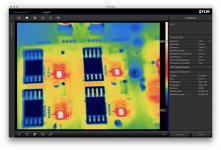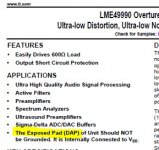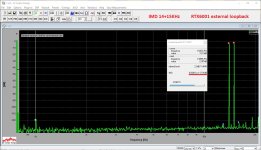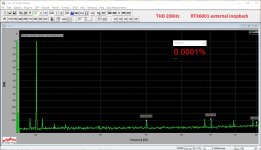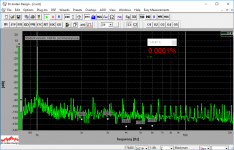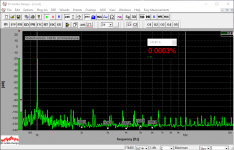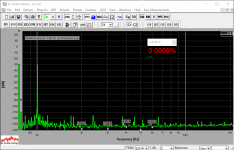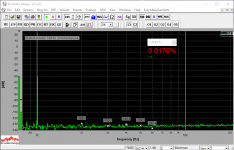The OPs close to the AD chip reach 76 degree celsius, those in the input stage are 70 degree, and those in the output stage are 66 degree. This worries me.
I've ordered several different types of heatsinks and will test them later.
I've ordered several different types of heatsinks and will test them later.
Attachments
It does get a bit warm. That is normal and nothing to worry about. To save electricity you might consider turning it off though, when not in use. It consumes almost 20W in idle.
I don't turn it on unless I'm going to use it, then it goes back off if I'm done for the day. I do this will all my test equipment. They only need 1/2 an hour at most to settle.
-Chris
-Chris
I turn on test equipment at most 30 minutes to an hour before I use it and shut it off when done.
I already waste sufficient energy I don't need to do that with test gear that is infrequently used and for which there is no demonstrated benefit.
Modern test equipment generally needs no more than 30 minutes to thermally stabilize and reach the maximum performance of which it is capable. I would argue that there isn't anything in this instrument that is not performing at specification within a few minutes if not sooner.
Nothing lasts forever, why shorten its service life by leaving it on all the time?
I already waste sufficient energy I don't need to do that with test gear that is infrequently used and for which there is no demonstrated benefit.
Modern test equipment generally needs no more than 30 minutes to thermally stabilize and reach the maximum performance of which it is capable. I would argue that there isn't anything in this instrument that is not performing at specification within a few minutes if not sooner.
Nothing lasts forever, why shorten its service life by leaving it on all the time?
The room temperature was around 20 degree celsius when I took these IR pictures of RTX60001, and the temperatures of these OPs can go as high as 76 degree in 20 mins after power on.
The room temperature can be more than 30 degree quite often in summer in my city, and I think these OPs may reach their maximum operating temperature, 85 degree, as well. That is one of the main reasons why I would like to install heatsinks.
The room temperature can be more than 30 degree quite often in summer in my city, and I think these OPs may reach their maximum operating temperature, 85 degree, as well. That is one of the main reasons why I would like to install heatsinks.
Hi,
The OP-amp(s) that gets hot is LME49990. This OP have exposed heat pad on the underside that could be soldered to the PCB for better heat transfer. On RTX6001 I was able to slide a paper strip under these OP's which means pad is not soldered.
The OP-amp(s) that gets hot is LME49990. This OP have exposed heat pad on the underside that could be soldered to the PCB for better heat transfer. On RTX6001 I was able to slide a paper strip under these OP's which means pad is not soldered.
There is no exposed pad on the LME49990.
Hi Jens,
From a datasheet I have, SNOSB16C –DECEMBER 2009–REVISED APRIL 2013. Maybe there is newer versions out there?
Attachments
Hi,
I took some temp measurements myself with a simple IR-thermometer at 23deg C ambient and open case. I got no more than 55 deg C (and my fingers agree) on the LME49990's. This temp should be safe I think. 75 deg C that PaulBC reported seem rather hot. What could be the reason for this 20 degree difference difference? Closed case that got opened prior to measurement?
I took some temp measurements myself with a simple IR-thermometer at 23deg C ambient and open case. I got no more than 55 deg C (and my fingers agree) on the LME49990's. This temp should be safe I think. 75 deg C that PaulBC reported seem rather hot. What could be the reason for this 20 degree difference difference? Closed case that got opened prior to measurement?
Hi,
I took some temp measurements myself with a simple IR-thermometer at 23deg C ambient and open case. I got no more than 55 deg C (and my fingers agree) on the LME49990's. This temp should be safe I think. 75 deg C that PaulBC reported seem rather hot. What could be the reason for this 20 degree difference difference? Closed case that got opened prior to measurement?
ir therms aren't so great for small components.
Hi nyt,
You are correct. However my IR has a very small opening (2.5 mm) and getting close I get reasonable temp readings (at least I think so). Closed vs open case makes a big difference. Just measuring the temp inside when case is closed should reveal the temp difference.
You are correct. However my IR has a very small opening (2.5 mm) and getting close I get reasonable temp readings (at least I think so). Closed vs open case makes a big difference. Just measuring the temp inside when case is closed should reveal the temp difference.
Hi Jens,
From a datasheet I have, SNOSB16C –DECEMBER 2009–REVISED APRIL 2013. Maybe there is newer versions out there?
I don't have a newer version, but I do have the parts. And there is no exposed pad, so it must be an error in the data sheet. The package drawing on page 18 doesn't show an exposed pad either.
Hi, Jens
You are of course right if the actual part has no exposed pad. Datasheet is then obviously wrong mentioning the exposed pad.
Please excuse me mentioning this exposed pad, I did only lookup the datasheet.
You are of course right if the actual part has no exposed pad. Datasheet is then obviously wrong mentioning the exposed pad.
Please excuse me mentioning this exposed pad, I did only lookup the datasheet.
I have received my device today - very happy with it! 😀
It 's been not an easy journey - DHL has brought it to Moscow, then notified me they don't deliver to individuals in Russia since 2010 and guess what ... sent it back to Denmark 🙄
RTX helped a lot, re-sending it via the normal post service, and voila - it's here.
A few initial analog loopback tests right out of the box with my WinAudioMLS - great performance, as expected
Many thanks to Jens and RTX (Lene) for all the great job they've done
Cheers,
Valery
It 's been not an easy journey - DHL has brought it to Moscow, then notified me they don't deliver to individuals in Russia since 2010 and guess what ... sent it back to Denmark 🙄
RTX helped a lot, re-sending it via the normal post service, and voila - it's here.
A few initial analog loopback tests right out of the box with my WinAudioMLS - great performance, as expected

Many thanks to Jens and RTX (Lene) for all the great job they've done

Cheers,
Valery
Attachments
Hello All.
I've got an interesting result that I can't explain - on the other PC.
With my powerful desktop workstation - no problem at all (post #918 above).
Exactly the same setup on the notebook - see attached.
Very strange "garbage" at the output. The pictures show 1KHz spectrum at 0db, -20db, -30db and -50db. Input is fine - those spikes are produced at the output.
Any ideas?
Cheers,
Valery
I've got an interesting result that I can't explain - on the other PC.
With my powerful desktop workstation - no problem at all (post #918 above).
Exactly the same setup on the notebook - see attached.
Very strange "garbage" at the output. The pictures show 1KHz spectrum at 0db, -20db, -30db and -50db. Input is fine - those spikes are produced at the output.
Any ideas?
Cheers,
Valery
Attachments
- Status
- Not open for further replies.
- Home
- Group Buys
- GB for RTX6001 Audio Analyzer with AK5394A and AK4490
